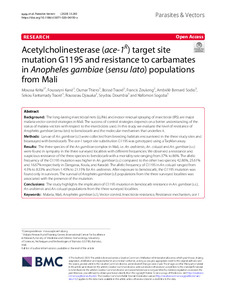| dc.contributor.author | Keïta, M. |
| dc.contributor.author | Kané, F. |
| dc.contributor.author | Thiero, O. |
| dc.contributor.author | Traoré, B. |
| dc.contributor.author | Zeukeng, F. |
| dc.contributor.author | Sodio, A.B. |
| dc.contributor.author | Traore, S.F. |
| dc.contributor.author | Djouaka, R.F. |
| dc.contributor.author | Doumbia, S. |
| dc.contributor.author | Sogoba, N. |
| dc.date.accessioned | 2022-08-19T08:43:49Z |
| dc.date.available | 2022-08-19T08:43:49Z |
| dc.date.issued | 2020 |
| dc.identifier.citation | Keïta, M., Kané, F., Thiero, O., Traoré, B., Zeukeng, F., Sodio, A.B., ... & Sogoba, N. (2020). Acetylcholinesterase (ace-1 R) target site mutation G119S and resistance to carbamates in Anopheles gambiae (sensu lato) populations from Mali. Parasites & Vectors, 13(283), 1-9. |
| dc.identifier.issn | 1756-3305 |
| dc.identifier.uri | https://hdl.handle.net/20.500.12478/7663 |
| dc.description.abstract | Background
The long-lasting insecticidal nets (LLINs) and indoor residual spraying of insecticide (IRS) are major malaria vector control strategies in Mali. The success of control strategies depends on a better understanding of the status of malaria vectors with respect to the insecticides used. In this study we evaluate the level of resistance of Anopheles gambiae (sensu lato) to bendiocarb and the molecular mechanism that underlies it.
Methods
Larvae of An. gambiae (s.l.) were collected from breeding habitats encountered in the three study sites and bioassayed with bendiocarb. The ace-1 target site substitution G119S was genotyped using a TaqMan assay.
Results
The three species of the An. gambiae complex in Mali, i.e. An. arabiensis, An. coluzzii and An. gambiae (s.s.) were found in sympatry in the three surveyed localities with different frequencies. We observed a resistance and suspicious resistance of the three species to bendiocarb with a mortality rate ranging from 37% to 86%. The allelic frequency of the G119S mutation was higher in An. gambiae (s.s.) compared to the other two species; 42.86%, 25.61% and 16.67% respectively in Dangassa, Koula, and Karadié. The allelic frequency of G119S in An. coluzzii ranged from 4.5% to 8.33% and from 1.43% to 21.15% for An. arabiensis. After exposure to bendiocarb, the G119S mutation was found only in survivors. The survival of Anopheles gambiae (s.l) populations from the three surveyed localities was associated with the presence of the mutation.
Conclusions
The study highlights the implication of G119S mutation in bendiocarb resistance in An. gambiae (s.s.), An. arabiensis and An. coluzzii populations from the three surveyed localities. |
| dc.description.sponsorship | TDR/WHO |
| dc.format.extent | 1-9 |
| dc.language.iso | en |
| dc.subject | Malaria |
| dc.subject | Mali |
| dc.subject | Anopheles Gambiae |
| dc.subject | Vectors |
| dc.subject | Defence Mechanisms |
| dc.title | Acetylcholinesterase (ace‑1R) target site mutation G119S and resistance to carbamates in Anopheles gambiae (sensu lato) populations from Mali |
| dc.type | Journal Article |
| cg.contributor.crp | Agriculture for Nutrition and Health |
| cg.contributor.affiliation | University of Sciences, Techniques and Technologies of Bamako |
| cg.contributor.affiliation | International Institute of Tropical Agriculture |
| cg.coverage.region | Africa |
| cg.coverage.region | West Africa |
| cg.coverage.country | Mali |
| cg.coverage.hub | Headquarters and Western Africa Hub |
| cg.researchtheme | Nutrition and Human Health |
| cg.identifier.bibtexciteid | KEITA:2020 |
| cg.isijournal | ISI Journal |
| cg.authorship.types | CGIAR and developing country institute |
| cg.iitasubject | Disease Control |
| cg.journal | Parasites & Vectors |
| cg.notes | Published online: 05 Jun 2020 |
| cg.accessibilitystatus | Open Access |
| cg.reviewstatus | Peer Review |
| cg.usagerightslicense | Creative Commons Attribution 4.0 (CC BY 0.0) |
| cg.targetaudience | Scientists |
| cg.identifier.doi | https://dx.doi.org/10.1186/s13071-020-04150-x |
| cg.iitaauthor.identifier | Rousseau Djouaka: 0000-0003-4772-0753 |
| cg.futureupdate.required | No |
| cg.identifier.issue | 283 |
| cg.identifier.volume | 13 |

